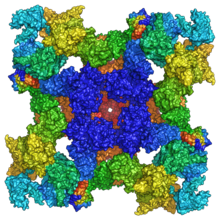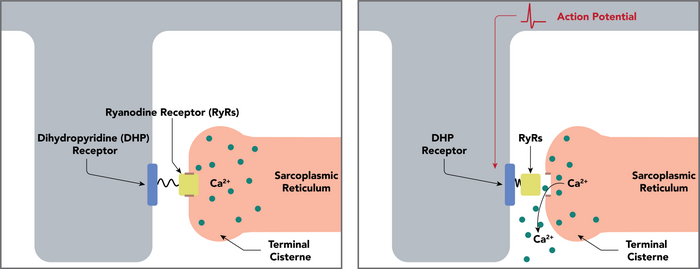Ryanodine receptor
| RyR domain | |||||||||
|---|---|---|---|---|---|---|---|---|---|
| Identifiers | |||||||||
| Symbol | RyR | ||||||||
| Pfam | PF02026 | ||||||||
| InterPro | IPR003032 | ||||||||
| TCDB | 1.A.3 | ||||||||
| OPM superfamily | 8 | ||||||||
| OPM protein | 5gl0 | ||||||||
| |||||||||
Ryanodine receptors(RyRfor short) form a class of intracellularcalcium channelsin various forms of excitable animaltissuelikemusclesandneurons.[1] There are three major isoforms of the ryanodine receptor, which are found in different tissues and participate in different signaling pathways involving calcium release from intracellular organelles. The RYR2 ryanodine receptor isoform is the major cellular mediator ofcalcium-induced calcium release(CICR) in animalcells.
Etymology[edit]

The ryanodine receptors are named after the plantalkaloidryanodinewhich shows a high affinity to them.
Isoforms[edit]
There are multiple isoforms of ryanodinereceptors:
- RyR1is primarily expressed inskeletal muscle
- RyR2is primarily expressed inmyocardium(heart muscle)
- RyR3is expressed more widely, but especially in thebrain.[2]
- Non-mammalian vertebrates typically express two RyR isoforms, referred to as RyR-alpha and RyR-beta.
- Many invertebrates, including the model organismsDrosophila melanogaster(fruitfly) andCaenorhabditis elegans,only have a single isoform. In non-metazoan species, calcium-release channels with sequence homology to RyRs can be found, but they are shorter than the mammalian ones and may be closer to IP3 Receptors.
|
|
| ||||||||||||||||||||||||||||||||||||||||||||||||||||||||||||||||||||||||||||||||||||||
Physiology[edit]
Ryanodine receptors mediate the release ofcalciumions from thesarcoplasmic reticulumandendoplasmic reticulum,an essential step inmuscle contraction.[1]Inskeletal muscle,activation of ryanodine receptors occurs via a physical coupling to thedihydropyridine receptor(a voltage-dependent,L-type calcium channel), whereas, incardiac muscle,the primary mechanism of activation iscalcium-induced calcium release,which causes calcium outflow from the sarcoplasmic reticulum.[3]
It has been shown thatcalciumrelease from a number of ryanodine receptors in a ryanodine receptor cluster results in a spatiotemporally restricted rise in cytosolic calcium that can be visualised as acalcium spark.[4]Ryanodine receptors are very close to mitochondria and calcium release from RyR has been shown to regulate ATP production in heart and pancreas cells.[5][6][7]
Ryanodine receptors are similar to theinositol trisphosphate (IP3or InsP3) receptor,and stimulated to transport Ca2+into the cytosol by recognizing Ca2+on itscytosolic side,thus establishing apositive feedbackmechanism; a small amount of Ca2+in the cytosol near the receptor will cause it to release even more Ca2+(calcium-induced calcium release/CICR).[1]However, as the concentration of intracellular Ca2+rises, this can trigger closing of RyR, preventing the total depletion of SR. This finding therefore indicates that a plot of opening probability for RyR as a function of Ca2+concentration is a bell-curve.[8]Furthermore, RyR can sense the Ca2+concentration inside the ER/SR and spontaneously open in a process known asstore overload-induced calcium release(SOICR).[9]
RyRs are especially important inneuronsandmuscle cells.Inheartandpancreascells, another second messenger (cyclic ADP-ribose) takes part in the receptor activation.
The localized and time-limited activity of Ca2+in the cytosol is also called aCa2+wave.The building of the wave is done by
- the feedback mechanism of the ryanodine receptor
- the activation ofphospholipase CbyGPCRorRTK,which leads to the production ofinositol trisphosphate,which in turn activates the InsP3receptor.
Associated proteins[edit]
RyRs form docking platforms for a multitude of proteins and small molecule ligands.[1] The cardiac-specific isoform of the receptor (RyR2) is known to form a quaternary complex with luminalcalsequestrin,junctin,andtriadin.[10]Calsequestrin has multiple Ca2+binding sites and binds Ca2+ions with very low affinity so they can be easily released.
Pharmacology[edit]
- Antagonists:[11]
- Ryanodinelocks the RyRs at half-open state at nanomolar concentrations, yet fully closes them at micromolar concentration.
- Dantrolenethe clinically used antagonist
- Ruthenium red
- procaine,tetracaine,etc. (local anesthetics)
- Activators:[12]
- Agonist:4-chloro-m-cresolandsuraminare direct agonists, i.e., direct activators.
- Xanthines likecaffeineandpentifyllineactivate it by potentiating sensitivity to native ligand Ca.
- Physiological agonist:Cyclic ADP-ribosecan act as a physiological gating agent. It has been suggested that it may act by makingFKBP12.6(12.6 kilodaltonFK506binding protein, as opposed to 12 kDa FKBP12 which binds to RyR1) which normally bind (and blocks) RyR2 channel tetramer in an average stoichiometry of 3.6, to fall off RyR2 (which is the predominant RyR in pancreatic beta cells, cardiomyocytes and smooth muscles).[13]
A variety of other molecules may interact with and regulate ryanodine receptor. For example: dimerizedHomerphysical tether linking inositol trisphosphate receptors (IP3R) and ryanodine receptors on the intracellular calcium stores with cell surfacegroup 1 metabotropic glutamate receptorsand theAlpha-1D adrenergic receptor[14]
Ryanodine[edit]
The plant alkaloid ryanodine, for which this receptor was named, has become an invaluable investigative tool. It can block the phasic release of calcium, but at low doses may not block the tonic cumulative calcium release. The binding of ryanodine to RyRs isuse-dependent,that is the channels have to be in the activated state. At low (<10 micromolar,works even at nanomolar) concentrations, ryanodine binding locks the RyRs into a long-lived subconductance (half-open) state and eventually depletes the store, while higher (~100 micromolar) concentrations irreversibly inhibit channel-opening.
Caffeine[edit]
RyRs are activated by millimolarcaffeineconcentrations. High (greater than 5 mmol/L) caffeine concentrations cause a pronounced increase (from micromolar to picomolar) in the sensitivity of RyRs to Ca2+in the presence of caffeine, such that basal Ca2+concentrations become activatory. At low millimolar caffeine concentrations, the receptor opens in a quantal way, but has complicated behavior in terms of repeated use of caffeine or dependence on cytosolic or luminal calcium concentrations.
Role in disease[edit]
RyR1mutationsare associated withmalignant hyperthermiaandcentral core disease.[15]Mutant-type RyR1 receptors exposed to volatile anesthetics or other triggering agents can display an increased affinity for cytoplasmic Ca2+at activating sites as well as a decreased cytoplasmic Ca2+affinity at inhibitory sites.[16]The breakdown of this feedback mechanism causes uncontrolled release of Ca2+into the cytoplasm, and increased ATP hydrolysis resulting from ATPase enzymes shuttling Ca2+back into the sarcoplasmic reticulum leads to excessive heat generation.[17]
RyR2 mutations play a role in stress-inducedpolymorphicventricular tachycardia(a form ofcardiac arrhythmia) andARVD.[2]It has also been shown that levels of type RyR3 are greatly increased inPC12 cellsoverexpressing mutant humanPresenilin 1,and in brain tissue in knockin mice that express mutant Presenilin 1 at normal levels,[18]and thus may play a role in the pathogenesis ofneurodegenerativediseases, likeAlzheimer's disease.[19]
The presence ofantibodiesagainst ryanodine receptors inblood serumhas also been associated withmyasthenia gravis(i.e., MG).[1]Individuals with MG who have antibodies directed against ryanodine receptors typically have a more severe form of generalized MG in which their skeletal muscle weaknesses involve muscles that govern basic life functions.[20]
Sudden cardiac death in several young individuals in the Amish community (four of which were from the same family) was traced to homozygous duplication of a mutant RyR2 (Ryanodine Receptor) gene.[21]Normal (wild type) ryanodine receptors are involved in CICR in heart and other muscles, and RyR2 functions primarily in the myocardium (heart muscle).
Structure[edit]

Ryanodine receptors are multidomain homotetramers which regulate intracellular calcium ion release from the sarcoplasmic and endoplasmic reticula.[22]They are the largest known ion channels, with weights exceeding 2 megadaltons, and their structural complexity enables a wide variety of allosteric regulation mechanisms.[23][24]
RyR1 cryo-EM structure revealed a large cytosolic assembly built on an extendedα-solenoidscaffold connecting key regulatory domains to the pore. The RyR1 pore architecture shares the general structure of the six-transmembrane ion channel superfamily. A unique domain inserted between the second and third transmembrane helices interacts intimately with paired EF-hands originating from the α-solenoid scaffold, suggesting a mechanism for channel gating by Ca2+.[1][25]
See also[edit]
- Ryanoid,a class of insecticide that act through ryanodine receptors
- Neuromuscular junction
- Dihydropyridine receptor
References[edit]
- ^abcdefSantulli G, Marks AR (2015). "Essential Roles of Intracellular Calcium Release Channels in Muscle, Brain, Metabolism, and Aging".Current Molecular Pharmacology.8(2): 206–222.doi:10.2174/1874467208666150507105105.PMID25966694.
- ^abZucchi R, Ronca-Testoni S (March 1997). "The sarcoplasmic reticulum Ca2+ channel/ryanodine receptor: modulation by endogenous effectors, drugs and disease states".Pharmacological Reviews.49(1): 1–51.PMID9085308.
- ^Fabiato A (July 1983). "Calcium-induced release of calcium from the cardiac sarcoplasmic reticulum".The American Journal of Physiology.245(1): C1-14.doi:10.1152/ajpcell.1983.245.1.C1.PMID6346892.
- ^Cheng H, Lederer WJ, Cannell MB (October 1993). "Calcium sparks: elementary events underlying excitation-contraction coupling in heart muscle".Science.262(5134): 740–744.Bibcode:1993Sci...262..740C.doi:10.1126/science.8235594.PMID8235594.
- ^Bround MJ, Wambolt R, Luciani DS, Kulpa JE, Rodrigues B, Brownsey RW, et al. (June 2013)."Cardiomyocyte ATP production, metabolic flexibility, and survival require calcium flux through cardiac ryanodine receptors in vivo".The Journal of Biological Chemistry.288(26): 18975–18986.doi:10.1074/jbc.M112.427062.PMC3696672.PMID23678000.
- ^Tsuboi T, da Silva Xavier G, Holz GG, Jouaville LS, Thomas AP, Rutter GA (January 2003)."Glucagon-like peptide-1 mobilizes intracellular Ca2+ and stimulates mitochondrial ATP synthesis in pancreatic MIN6 beta-cells".The Biochemical Journal.369(Pt 2): 287–299.doi:10.1042/BJ20021288.PMC1223096.PMID12410638.
- ^Dror V, Kalynyak TB, Bychkivska Y, Frey MH, Tee M, Jeffrey KD, et al. (April 2008)."Glucose and endoplasmic reticulum calcium channels regulate HIF-1beta via presenilin in pancreatic beta-cells".The Journal of Biological Chemistry.283(15): 9909–9916.doi:10.1074/jbc.M710601200.PMID18174159.
- ^Meissner G, Darling E, Eveleth J (January 1986). "Kinetics of rapid Ca2+ release by sarcoplasmic reticulum. Effects of Ca2+, Mg2+, and adenine nucleotides".Biochemistry.25(1): 236–244.doi:10.1021/bi00349a033.PMID3754147.
- ^Van Petegem F (September 2012)."Ryanodine receptors: structure and function".The Journal of Biological Chemistry.287(38): 31624–31632.doi:10.1074/jbc.r112.349068.PMC3442496.PMID22822064.
- ^Handhle A, Ormonde CE, Thomas NL, Bralesford C, Williams AJ, Lai FA, Zissimopoulos S (November 2016)."Calsequestrin interacts directly with the cardiac ryanodine receptor luminal domain".Journal of Cell Science.129(21): 3983–3988.doi:10.1242/jcs.191643.PMC5117208.PMID27609834.
- ^Vites AM, Pappano AJ (March 1994). "Distinct modes of inhibition by ruthenium red and ryanodine of calcium-induced calcium release in avian atrium".The Journal of Pharmacology and Experimental Therapeutics.268(3): 1476–1484.PMID7511166.
- ^Xu L, Tripathy A, Pasek DA, Meissner G (September 1998). "Potential for pharmacology of ryanodine receptor/calcium release channels".Annals of the New York Academy of Sciences.853(1): 130–148.Bibcode:1998NYASA.853..130T.doi:10.1111/j.1749-6632.1998.tb08262.x.PMID10603942.S2CID86436194.
- ^Wang YX, Zheng YM, Mei QB, Wang QS, Collier ML, Fleischer S, et al. (March 2004). "FKBP12.6 and cADPR regulation of Ca2+ release in smooth muscle cells".American Journal of Physiology. Cell Physiology.286(3): C538–C546.doi:10.1152/ajpcell.00106.2003.PMID14592808.S2CID20900277.
- ^Tu JC, Xiao B, Yuan JP, Lanahan AA, Leoffert K, Li M, et al. (October 1998)."Homer binds a novel proline-rich motif and links group 1 metabotropic glutamate receptors with IP3 receptors".Neuron.21(4): 717–726.doi:10.1016/S0896-6273(00)80589-9.PMID9808459.S2CID2851554.
- ^Robinson RL, Brooks C, Brown SL, Ellis FR, Halsall PJ, Quinnell RJ, et al. (August 2002)."RYR1 mutations causing central core disease are associated with more severe malignant hyperthermia in vitro contracture test phenotypes".Human Mutation.20(2): 88–97.doi:10.1002/humu.10098.PMID12124989.S2CID21497303.
- ^Yang T, Ta TA, Pessah IN, Allen PD (July 2003)."Functional defects in six ryanodine receptor isoform-1 (RyR1) mutations associated with malignant hyperthermia and their impact on skeletal excitation-contraction coupling".The Journal of Biological Chemistry.278(28): 25722–25730.doi:10.1074/jbc.m302165200.PMID12732639.
- ^Reis M, Farage M, de Meis L (2002-01-01)."Thermogenesis and energy expenditure: control of heat production by the Ca(2+)-ATPase of fast and slow muscle".Molecular Membrane Biology.19(4): 301–310.doi:10.1080/09687680210166217.PMID12512777.S2CID10720335.
- ^Chan SL, Mayne M, Holden CP, Geiger JD, Mattson MP (June 2000)."Presenilin-1 mutations increase levels of ryanodine receptors and calcium release in PC12 cells and cortical neurons".The Journal of Biological Chemistry.275(24): 18195–18200.doi:10.1074/jbc.M000040200.PMID10764737.
- ^Gong S, Su BB, Tovar H, Mao C, Gonzalez V, Liu Y, et al. (June 2018)."Polymorphisms Within RYR3 Gene Are Associated With Risk and Age at Onset of Hypertension, Diabetes, and Alzheimer's Disease".American Journal of Hypertension.31(7): 818–826.doi:10.1093/ajh/hpy046.PMID29590321.
- ^Gilhus NE (July 2023)."Myasthenia gravis, respiratory function, and respiratory tract disease".Journal of Neurology.270(7): 3329–3340.doi:10.1007/s00415-023-11733-y.PMC10132430.PMID37101094.
- ^Tester DJ, Bombei HM, Fitzgerald KK, Giudicessi JR, Pitel BA, Thorland EC, et al. (March 2020)."Identification of a Novel Homozygous Multi-Exon Duplication in RYR2 Among Children With Exertion-Related Unexplained Sudden Deaths in the Amish Community".JAMA Cardiology.5(3): 13–18.doi:10.1001/jamacardio.2019.5400.PMC6990654.PMID31913406.
- ^Santulli G, Lewis D, des Georges A, Marks AR, Frank J (2018). "Ryanodine Receptor Structure and Function in Health and Disease". In Harris JR, Boekema EJ (eds.).Membrane Protein Complexes: Structure and Function.Vol. 87. Singapore: Springer Singapore. pp. 329–352.doi:10.1007/978-981-10-7757-9_11.ISBN978-981-10-7756-2.PMC5936639.PMID29464565.
{{cite book}}:|journal=ignored (help) - ^Lanner JT, Georgiou DK, Joshi AD, Hamilton SL (November 2010)."Ryanodine receptors: structure, expression, molecular details, and function in calcium release".Cold Spring Harbor Perspectives in Biology.2(11): a003996.doi:10.1101/cshperspect.a003996.PMC2964179.PMID20961976.
- ^Van Petegem F (January 2015). "Ryanodine receptors: allosteric ion channel giants".Journal of Molecular Biology.427(1): 31–53.doi:10.1016/j.jmb.2014.08.004.PMID25134758.
- ^Zalk R, Clarke OB, des Georges A, Grassucci RA, Reiken S, Mancia F, et al. (January 2015)."Structure of a mammalian ryanodine receptor".Nature.517(7532): 44–49.Bibcode:2015Natur.517...44Z.doi:10.1038/nature13950.PMC4300236.PMID25470061.
External links[edit]
- Ryanodine+Receptorat the U.S. National Library of MedicineMedical Subject Headings(MeSH)

